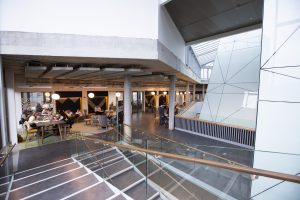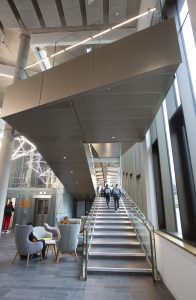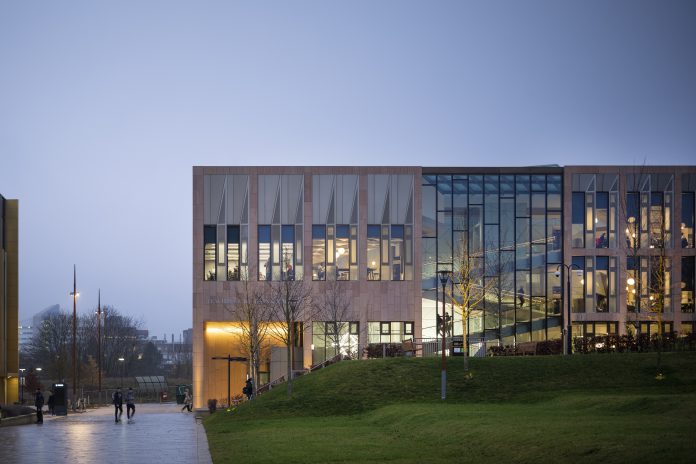Following its completion earlier this year, the University of Birmingham’s Teaching & Learning (T&L) Building has become a symbol of innovation and collaboration across the city
Overlooking the recently developed landscape of the Green Heart, this educational hub provides state-of-the-art teaching, learning and study environments for students at the heart of the university’s Edgbaston campus.
Delivered by national contractor Willmott Dixon, the £22.7m project incorporated a range of innovative building techniques to create an extraordinary structure that is both practical and aesthetically pleasing.
At its centre, the building features a crystal structure that houses a 500-seat traditional lecture theatre and a 250-seat collaborative lecture theatre set underneath a Glulam ceiling. This structure is surrounded by 10 seminar rooms and open learning spaces for up to 1,000 students – providing areas for individual study and collaborative work – and a new café.
Nick Heath, Willmott Dixon’s director of delivery for the project, said: “The T&L Building was an incredible project to work on – it tested the inventiveness and creativity of the whole team who worked hard to find new solutions that allowed the construction of this multidimensional structure to succeed.
“Despite some of the challenges we faced due to the complexities of the building’s design, we were able to utilise modern construction methods to make sure that the delivery of the project was in accordance to the architect and customer’s vision of contemporary and collaborative learning.”
A myriad of design elements
This project’s unique combination of one structure inside another meant that the design and construction of the build had to be carefully navigated.
The inner crystal structure – which houses two lecture theatres and rises through the centre of the building – is surrounded by a cluster of smaller, concrete learning spaces to encourage students to use university facilities beyond their timetabled hours.
These seminar rooms and self-directed learning spaces are connected to the crystal by a network of bridges and can be accessed by roman steps, which give the structure transparency and allow free-flowing movement throughout the building.
Accessibility was a key aspect in the building’s design, ensuring that 1,000 students could flow through the space with 10-minute turnaround every hour – as well as catering for full accessibility in lecture theatres and seminar space.
Experts from BDP, RLF and Willmott Dixon worked closely together to ensure the project was structurally sound.
Heath explained: “The crystal interior is a flexible steel structure, clad in 730 unique pieces of Stoventec glazed panels that have a 5mm tolerance for installation. These panels were made in Bulgaria with extensive lead times and so needed to be manufactured prior to the steel structure being completed.
“The seamless installation of the crystal within 5mm tolerances is testimony to the collective planning, collaboration and shared understanding from all those involved. It had the right design delivered at the right time, installed in the right way.
“This was the first major project at the University of Birmingham to fully coordinate AV and FFE within the contractor’s package, and detailed commissioning, installation and planning was needed to successfully transition the building to an operational facility.
“Sensory disabilities were also considered during the project through the finalisation of colour, fabric and finishes, along with the creation of enclosed, quieter spaces to provide pockets of comfort within the open-plan design.”
Innovation through digital technology
The intricate details and design elements of the crystal and surrounding structures created challenges that were met by the Willmott Dixon team, who collaborated to provide solutions through their innovative use of digital technology.
The Stoventec glazed panels were measured off the federated model for manufacture. While the team were building the steel structure, a cloud point survey was undertaken at each level to overlay back in the model to ensure accuracy of fabrication and final positions.
Heath said: “The use of digital technology provided more than just a visualisation tool at the front end of the design process – it was integral to planning the project and ensuring everything was completed to a high standard.
“Without the federated model, we would have not been able to procure all items in appropriate lead times to successfully deliver the project. We also undertook construction rehearsals which enables us to refine the sequencing of works.”
The steel frame was then adjusted to ensure that it matched the model perfectly to manage 5mm tolerance in the glazing. This process was undertaken at every step of frame’s construction, before the glazing arrived in batches with a unique reference, fitting onto the structure like a jigsaw puzzle.
The innovative internal scaffolding solution mirrored the outward and inward slopes of the inner crystal to enable safe access during the installation of glazing. This meant the internal scaffolding was on site for a longer period and internal works had to be correctly sequenced to continue with the programme.
Social and environmental value
The contractor didn’t sacrifice its high sustainability standards to accommodate the T&L Building’s innovative design, instead delivering them hand in hand.
Heath said: “Throughout the build, we prioritised the use of responsibly sourced materials and optimised elemental lifecycle costing to advise on material specification. For example, the atrium balustrade fitted with a robust timber cladding material to reduce maintenance and replacement costs, and a glass balustrade specified for the main staircase to minimise redecoration costs.”
The design also included the provision of a 300m2 PV array helping to reduce the building’s energy demand that will lead to a saving of 21 tonnes of CO2 per annum. The project was not only environmentally sustainable but also added social value to local students and communities.
Heath said: “Student engagement was key throughout the completion of the scheme and two engineering students played an integral role throughout its lifecycle by providing input through site visits, product manufacturing assessments and advising on final selections.
“Our team was joined by 233 other students who visited the site and 971 students who attended workshops about the project. The scheme also supported 22 university research projects, offering experiential learning to supplement academic research on a range of courses.”
Throughout the project, 45 weeks of on-site apprenticeship training and 107 weeks of work experience were completed and an additional 26 NVQ students were supported, and a new job was created for one local candidate.
The project also worked alongside the local community, supporting the industry-wide initiative of Open Doors that enabled the public to see behind the schemes of the project in its early construction stages.
This social value was limited not only to local students and members of the community but also extended to the contractor’s supply chain.
Following the closure of the steel frame company just days before work was due to commence on the project, Willmott Dixon worked tirelessly to purchase the steel and hire the fixers that were due to be erecting the frame, providing them with work when they would have previously been left unemployed, all without hindering the project delivery time or budget.
The impact of design
The forward-thinking design of the University of Birmingham’s new T&L Building provides students with more diverse, high-quality learning spaces on the Edgbaston campus.
From day one, the social learning spaces have been near full capacity during term time with students adapting seamlessly to the new environment. Study spaces are being used as intended, encouraging students to inhabit the building beyond the formal timetable supporting the ‘sticky campus’ concept.
Through a combination of complex design and digital technology, the Willmott Dixon team was able to collaborate with BDP and RLF to create a scheme that enhances progressive learning and encourages interaction between students and teaching staff.
The structure not only promotes collaboration and innovation through its design but also houses the right environment and resources for these skills to be exercised by its users.
Willmott Dixon
+44 (0)1462 671852
Twitter: @willmottdixon
LinkedIn: Willmott Dixon
YouTube: Willmott Dixon














